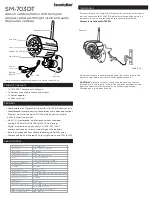
9
III. Maintenance tips
-
Do not spray chemical aerosol like air freshener, hairspray, perfume,
insecticide or spray paint near the alarm.
-
Do not paint the CO alarm. If you need to paint the wall and floor, please
put the alarm into a clean plastic bag first. After the smell has been fully
volatilized, install the alarm again.
-
Do not block up or cover the alarm’s venthole with paste adhesive or other
things.
-
If the detector falls on the floor, pick it up to check whether the battery
is fixed well. After making sure the battery is installed well, press the TEST
button again to see if the functions run well before installing it again.
The detector has been calibrated before leaving the factory. If you dismantle it
without permission and change any component or software, it may cause false
alarm or malfunction. Don’t dismantle or modify any component or program.
9. What to do upon CO alarm detection
IV. General carbon monoxide information
Carbon monoxide is a colorless and odorless gas which can cause people to
die and will engender when any combustible material burns. When burning
the combustible material in the limited room, higher concentration carbon
monoxide will be engendered. When people absorb a certain amount of carbon
monoxide, they will die. Now many countries’ Consumer Product Safety Com-
missions have warned the public the harm of fatal family poison gas and make
the carbon monoxide poison as the first public safety problem.
V. Possible sources of carbon monoxide
In home, carbon monoxide may be engendered from heating and burning
equipment, such as stove, water heater, fireplace, charcoal-burning grill, natural
gas furnace, heating devices, microgenerator and so on. Vehicles running in
attached garages can also produce CO.
When these devices are in well-ventilated condition or in normal working condi-
tion, the amount of carbon monoxide will be little and discharged quickly with-
out doing harm to people. But when there is lack of oxygen or the burning is not
sufficient, or the devices have problems, high concentration carbon monoxide
will engender. Because the ventilation is not good, and the carbon monoxide is
not given off quickly, the high concentration carbon monoxide will be accumu-
lated to the extent that will harm people’s health.
Warning:
The product only indicates the presence of carbon monoxide, and warns people
to deal with the situation or leave. It cannot prevent CO from occurring.
VI. Symptoms of CO poisoning
-
Common mild symptoms: Slight headache, nausea, vomiting, fatigue.
-
Common medium symptoms : Headache, drowsiness, confusion, fast heart
rate.
-
Common severe symptoms : Convulsion, unconsciousness, cardio-
respiratory failure, braininjury, death.
Young children and the elderly may be more vulnerable. Please pay attention to
high-risk persons because they may experience a more dangerous situation at a
certain level.
If you experience even mild symtoms of CO poisoning, please consult your
doctor immediately!
VII. Actions to take when an alarm sounds
As carbon monoxide can kill your lives, please take the following actions if the
product alarms:
-
Stop using all fuel-burning appliances and ensure that they are turned off.
Open doors and windows quickly. Turn on ventilation and exhaust systems.
-
Make sure all the people move to fresh air immediately. Call emergency
service for help. Don’t reenter the premises until the alarm stops and
remains in normal condition.
-
Get medical help for anyone suffering the effects of carbon monoxide
poisoning.
-
If the alarm reactivates within 24 hours, repeat above steps and call a
qualified appliance technician to investigate sources of CO from fuel
burning equipment and appliances, and to check if ventilation and exhaust
system is working properly. If problems are identified during the inspection,
stop using the equipment immediately. Let qualified appliance technician
repair it.
566025107
EN










































